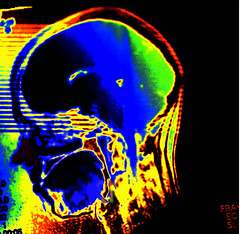The robotic arm clutched a glass and swung it over a series of coloured dots that resembled a Twister gameboard. Behind it, a woman sat immobile in a wheelchair. Slowly, the arm put the glass down, narrowly missing one of the dots.
“She’s doing that!” exclaims Professor John Donoghue, watching a video of the scene on his office computer – though the woman onscreen had not moved at all.
“She has the arm under her control,” he says, beaming with pride. “We told her to put the glass down on that dot.”
The woman, who is almost completely paralysed, was using Donoghue’s groundbreaking technology to control the robot arm with only her thoughts.
Called BrainGate, the device is implanted into her brain and hooked to a computer to which she sends mental commands.
The video played on, giving Donoghue, 62, even more reason to feel pleased. The patient was not satisfied with her near miss and the robot arm lifted the glass again.
After a brief hover, the arm positioned the glass on the dot.
This is the remarkable world of the brain-computer interface, or BCI, of which BrainGate is one of the leading devices and Donoghue one of its most successful pioneers.
It sounds like science fiction, but it is motivated by a desire to help chronically injured people. They include those who have lost limbs, have motor-neurone disease or are paralysed by spinal cord injuries.
But the people it might help the most are those whom medicine assumed were beyond all hope, those with “locked-in syndrome“.
These are often stroke victims whose healthy minds are trapped inside bodies that can no longer move.
The most famous example was French magazine editor Jean-Dominique Bauby who managed to dictate a memoir, The Diving Bell and the Butterfly, by blinking one eye.
In the book, Bauby, who died in 1997 shortly after the book was published, described the prison his body had become for a mind that still worked normally.
Donoghue believes BrainGate would have opened Bauby’s prison door, even if just a little.
He and his team have devoted years of research to BrainGate, first testing the technology on monkeys and then moving to clinical trials using human subjects.
Now the project is involved with a second set of human trials, pushing the technology to see how far it goes and trying to miniaturise it and make it wireless for a better fit in the brain.
BrainGate’s concept is simple. It plugs into the brain, picks up neural signals and beams them into a computer where they are translated into moving a cursor or controlling a computer keyboard.
With it, paralysed people can move a robot arm or drive their own wheelchair, just by thinking about it.









